|
Ancoats - A Brief
Introduction
|
||||
|
This will not be a
comprehensive history of the Ancoats district of
Manchester. My
aim is to document what is going on there today and to
watch it over
the coming years. This introduction is my
attempt to explain what
you can see in Ancoats today, what was there before
and what is on the
way. The image below shows Ancoats in the
1940s. As you can
see it was a densly packed industrial and residential
area.
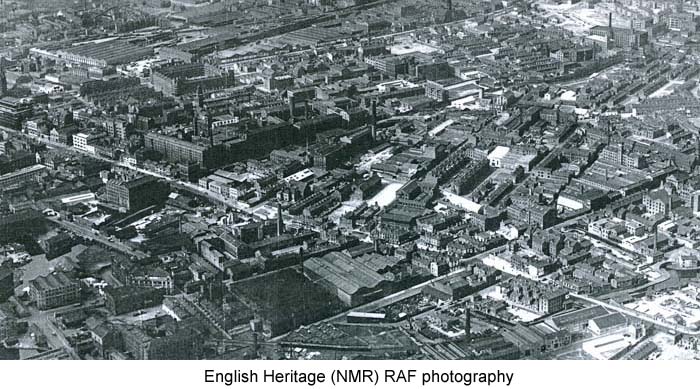 The area is much
changed
especially the area known as New Islington,
between the Rochdale Canal
and the Ashton Canal. When you leave
Manchester's
Northern Quarter today and cross Great Ancoats
Street you enter
Ancoats. Today it is an extensive
brownsfield development site,
in which you will find restored historic buildings
beside modern
residential houses and flats. In every
direction you will see
building work ranging from demolition to
restoration to construction.
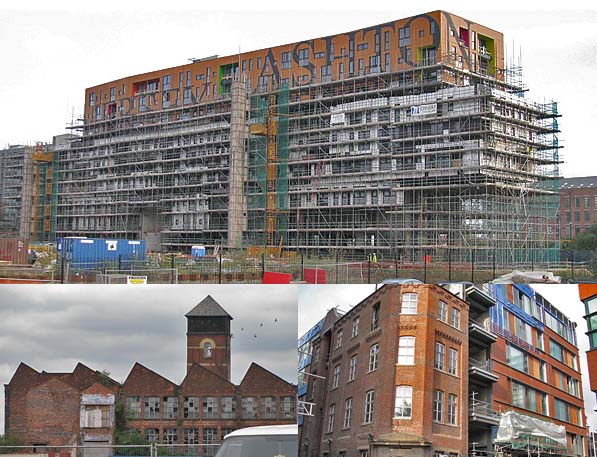 In the 18th Century
Ancoats had
a distinctly rural appearance but the arrival of the
canals and the
industrial revolution transformed the area.
Frederick Engles in
his book "The Condition of the Working Class in
England", published in
1845, said of Ancoats, "In ...Ancoats, stand the
largest mills of
Manchester lining the canals, colossal six and
seven-storied buildings
towering with their slender chimneys far above the low
cottages of the
workers.
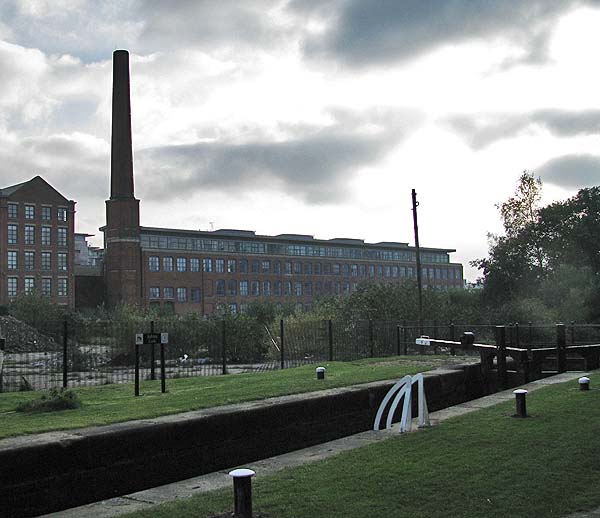 The industrial
activity
attracted immigrants to Manchester and those who came
from Italy
settled in large numbers in Ancoats. It became
known as Little
Italy although the fact is that it was also home to
people from Ireland
and Poland. There is still a pub called "The
Shamrock"
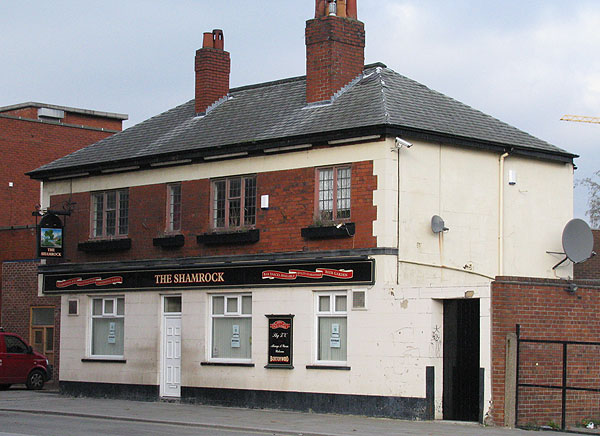 and one of the buildings being redeveloped is the Ice Plant evidence of the fact that once 70 ice cream barrow businesses thrived in Little Italy. 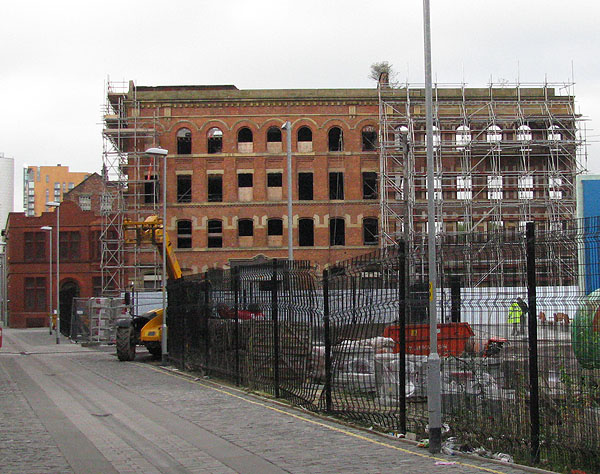  In the Pevsner Guide to the architecture of Manchester there is an entry about the remains of the former Ancoats Police and Fire Station. 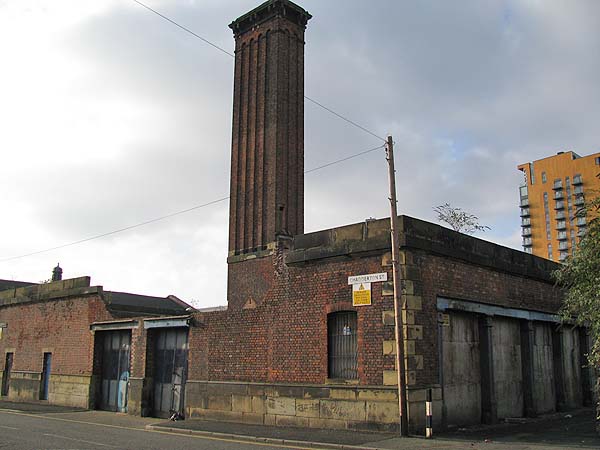 It describes it as a, "forceful, even monumental, design ... something more akin to a stronghold was required in this notoriously lawless area. In 1960 many of the slum houses were cleared and between the Rochdale and Ashton Canals a new estate known as the Cardroom Estate was created. It has been said of the Cardroom that "There were no through roads and many of the homes did not face streets, there was little definition between public and private space and the area was difficult to police. Many people moved away and those who stayed felt increasingly marginalised - shops had insufficient custom to stay open, pubs closed and the final blow was the closure of the primary school due to lack of numbers. ....Cardroom became a sink estate, people moved in with track records of anti-social behaviour and began to take the area down with them." It became, "An estate where people lock themselves in after dark, where the nearest shop is 15 minutes walk away, where the open spaces belonged to the joyrider. An estate where the police wouldn’t go, where catalogue shops wouldn’t deliver, where taxis wouldn’t drop off." So what changed? Ancoats is today in the midst of a massive re-envigoration that proposes to save the best of the past while creating a vibrant mixed use community. The accusation has been leveled that what is happening is that Ancoats is being gentrified for the Yuppies and people point to the fact that one portion of it has been renamed New Islington, which they see as an obvious connection to the Islington of Tony Blair and the London Middle Class. 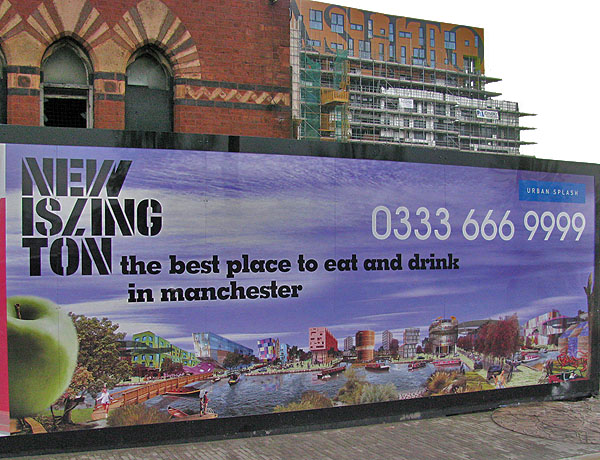 Whether or not this is true remains to be seen but the New Islington slur is in fact unfounded because back in the 1800s that was what the area was called. Broadly there are two redeveloment areas within Ancoats. From Great Ancoats Street on the west with Oldham Road and the Rochdale Canal marking its northern and southern boundaries is the Ancoats Urban Village. Between the Rochdale Canal and the Ashton Canal, where the former Cardroom Estate stood is New Islington. 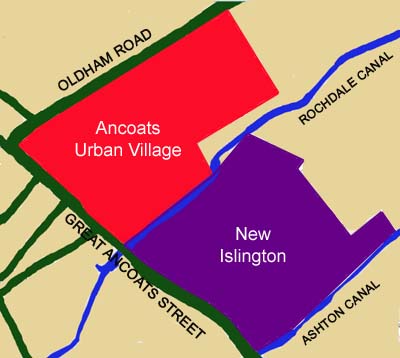 Ancoats Urban Village The image below shows this area in the 1940s. 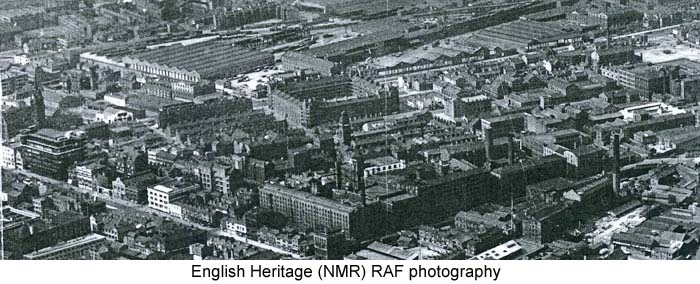 Today the Ancoats
Urban Village
contains the iconic Express Building, the terraced
houses on George
Leigh Street, the former George Leigh Street School,
the Victoria
Square Flats, St Peter's Church, The Ice Plant, Sarah
Village
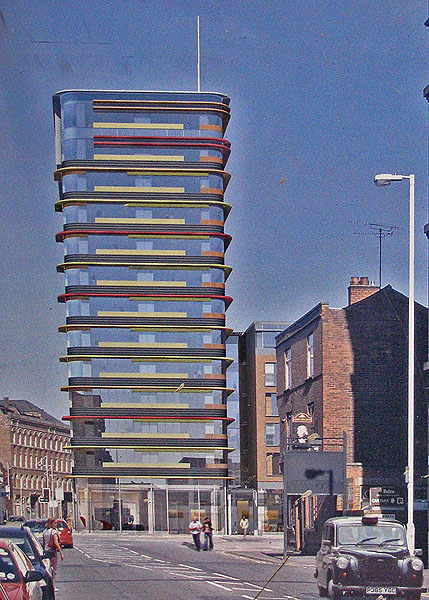 and the magnificent
restored
mills.
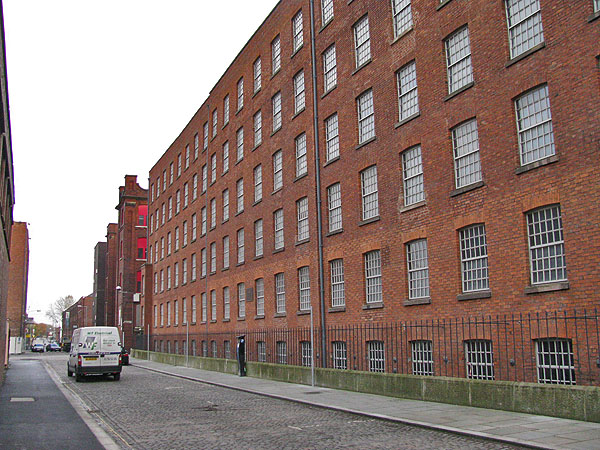 New Islington The photograph below
focuses in
on the area south of the Rochdale Canal as it was in
the 1940s.
Most of the buildings are gone. The numbers on
the map identify
some of the important locations.
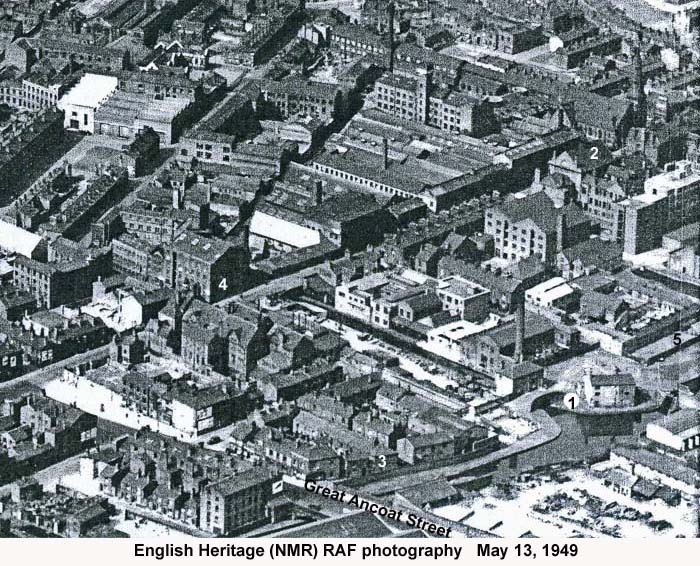
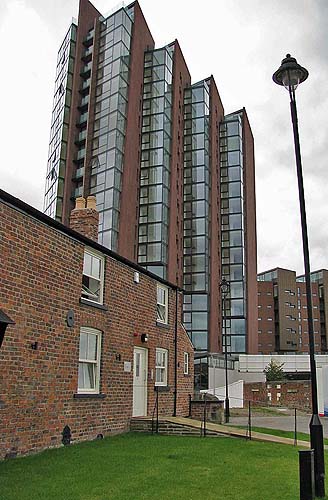 Old Mill Street
itself is
marked by a row of rust coloured and very
distinctive street lights
above what will be a wide pedestrianized
promenade.
 A series of sculpted metal plaques are embedded in the roadway. 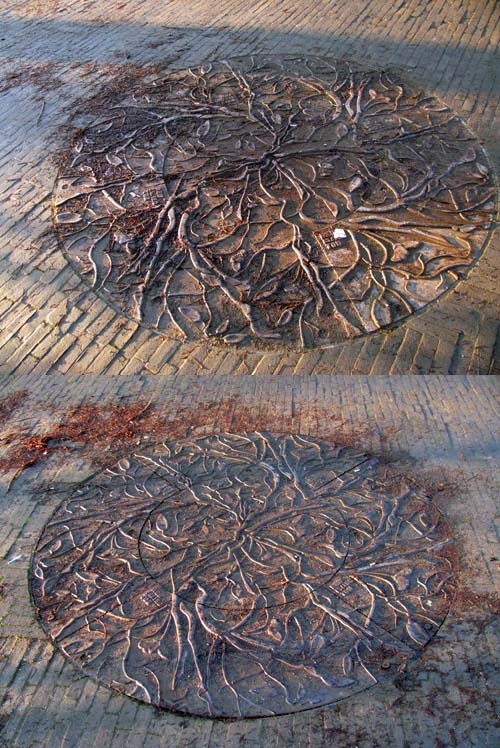 To the north of the street the old estate has been swept away and a new canal and wharves have been created as a water park around which a new community will be built. 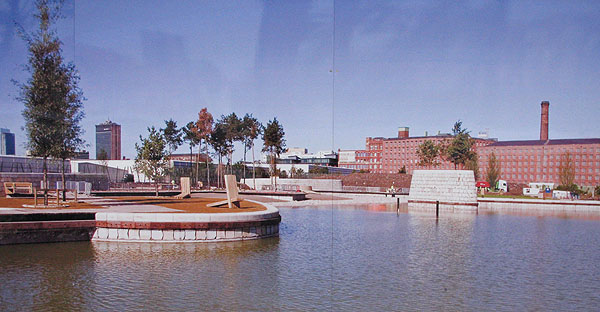 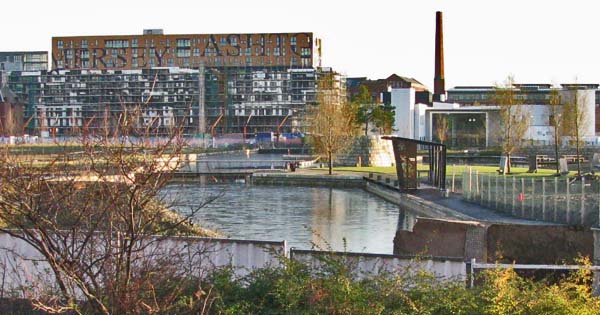 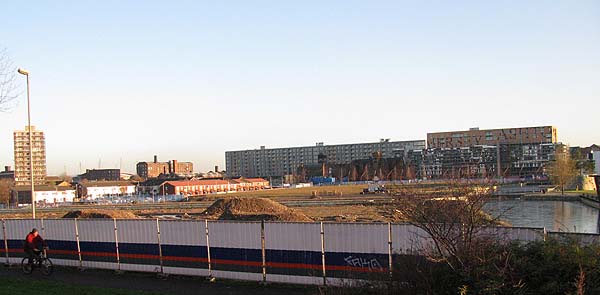 On the far side of it stands Islington Square an exotic looking group of terrace houses built around a block of internal gardens. 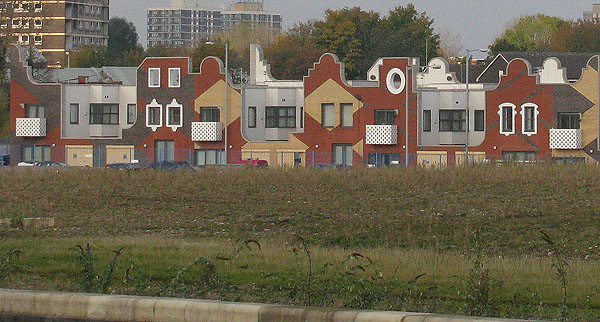 On the side of one of the new wharves there are plans to build a residential complex known as Tutti Frutti, a clear homage to the areas ice-cream history as well as a reflection of what the concept entails. A series of individual lots will be sold privately and on each lot the owners will design their own home which will be tied into the one next to it creating a terrace. This concept has been used already in Holland.  South of Old Mill
Street the
old Ancoats Dispensary sits in a derelict state but it
is to be
incorporated into an ultra-modern residential complex
designed by Ian
Simpson, Architects, the creators of Urbis and the
Betham Tower.
Behind the dispensary work is ongoing on Chips a
unique residential
block made up of three curved elements stacked one on
top of the other
and resembling a stack of chips. The special
cladding on the
building has in it words that remind people of the
areas history.
 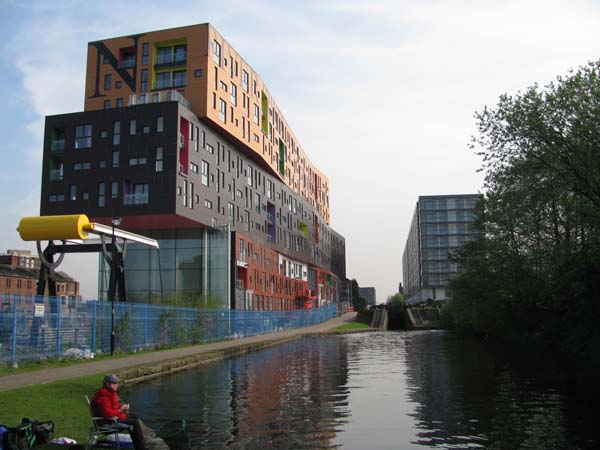 The New Islington development includes a new health centre and includes plans for outdoor recreation, a large food retail shop and a primary school. Work continues in Ancoats and the area is very much a building site. How it will fair in the time of economic uncertainty is unclear, whether all of the grand plans will come to fruition is still to be seen, whether this new community functions better than its predecessors only time will tell. |